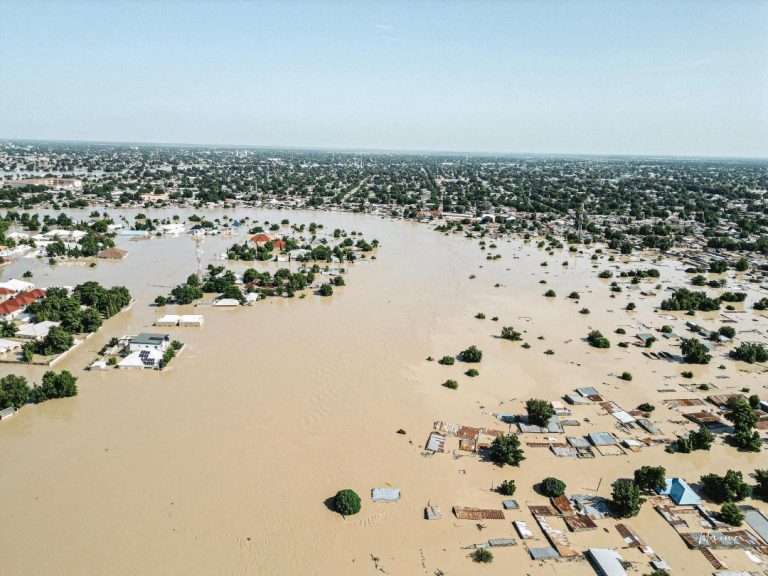The Nigeria Hydrological Services Agency (NiHSA) has issued a new flood alert following its latest monitoring, which indicates elevated water levels along sections of the River Niger and River Benue.
According to the agency, this raises the risk of flooding in Kogi, Anambra, and Delta states. NiHSA also identified Benue, Adamawa, Niger, and Bayelsa states as areas with potential flood risks.
The agency highlighted that recent flood evaluation exercises detected contamination in some shallow wells, caused by floodwater intrusion. NiHSA’s Director General and Chief Executive Officer, Umar Muhammed, shared the update during a press briefing in Abuja on Thursday.
“At the moment, our hydrological monitoring shows high water levels along parts of the Niger and Benue Rivers, with the possibility of localised flooding in Kogi, Anambra, and Delta states. We advise residents in flood-prone areas to remain vigilant and follow official advisories,” Muhammed stated.
He added, “Our recent water quality assessment during flood evaluation exercises revealed contamination in some shallow wells caused by floodwater intrusion. We call for stronger collaboration among relevant ministries, humanitarian partners, and local authorities to ensure the provision of safe drinking water to affected communities.”
The warning highlights ongoing concerns about Nigeria’s flood preparedness, especially amid changing climate patterns. The alert not only serves as a precautionary measure but also as a call for coordinated action between federal, state, and local authorities to reduce the anticipated impacts.
Muhammed further revealed that NiHSA is preparing a Five-Year Strategic Action Plan to enhance its operations. This plan focuses on innovation, regional empowerment, and stronger stakeholder engagement. “NiHSA is also strengthening its zonal and field offices to bring our services closer to the people. All these efforts are in line with the Renewed Hope Agenda of President Bola Ahmed Tinubu, which emphasizes innovation, accountability, and measurable results,” he said.
The DG reaffirmed NiHSA’s commitment to a proactive, data-driven approach aimed at saving lives, protecting infrastructure, and enhancing Nigeria’s resilience to climate change impacts. He noted that the agency has expanded real-time data collection and upgraded early warning systems, using satellite imagery, digital modelling, and on-ground measurements to improve flood risk prediction and communication.
“Across the country, NiHSA maintains a wide network of hydrological and groundwater monitoring stations. These provide real-time information for forecasting, planning, and decision-making. Through hydrogeological mapping, river discharge measurements, and floodplain studies, we help states and local communities make informed choices about land use, infrastructure, and water management,” he explained.
Muhammed also highlighted that the Annual Flood Outlook is one of NiHSA’s flagship publications, offering yearly forecasts of flood scenarios across all states and guiding preparedness at both national and local levels. He stressed that collaboration is central to the agency’s operations, citing strong partnerships with national institutions such as the Nigerian Meteorological Agency, the National Emergency Management Agency, and the National Water Resources Institute. Regional and international organisations, including the Lake Chad Basin Commission, Niger Basin Authority Operational Support System, the World Meteorological Organization, UNESCO, ECOWAS, and the International Atomic Energy Agency, also contribute to capacity building, coordination, and alignment with global best practices.
Speaking at the briefing, NiHSA Technical Adviser Stephen Jabo noted that Benue, Adamawa, Niger, and Bayelsa states remain at high risk of flooding. He explained that although the rainy season is expected to end in most regions by November, severe flooding could still occur in the coming weeks due to elevated water levels in the Niger and Benue Rivers.
Jabo urged communities along these riverbanks to stay vigilant and follow safety measures, stating, “What states can do for those communities located along the riverbanks of Rivers Niger and Benue is to sensitise them to remain on high alert, move to higher ground, and be aware of the locations of designated flood camps. In the event of flooding, they should be ready for evacuation.”
He also warned against walking or swimming through floodwaters and emphasised the importance of clearing drainage systems to ensure water flows freely, thereby reducing flood risks.


